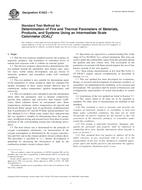Potřebujeme váš souhlas k využití jednotlivých dat, aby se vám mimo jiné mohly ukazovat informace týkající se vašich zájmů. Souhlas udělíte kliknutím na tlačítko „OK“.
ASTM E1623-11
Standard Test Method for Determination of Fire and Thermal Parameters of Materials, Products, and Systems Using an Intermediate Scale Calorimeter (ICAL)
Automaticky přeložený název:
Standardní zkušební metoda pro stanovení ohně a tepelných parametrů materiálů, výrobků a systémů využívajících meziproduktu Scale kalorimetru ( ICAL )
NORMA vydána dne 1.1.2011
Informace o normě:
Označení normy: ASTM E1623-11
Poznámka: NEPLATNÁ
Datum vydání normy: 1.1.2011
Kód zboží: NS-42422
Počet stran: 22
Přibližná hmotnost: 66 g (0.15 liber)
Země: Americká technická norma
Kategorie: Technické normy ASTM
Anotace textu normy ASTM E1623-11 :
Keywords:
effective specific heat, effective thermal conductivity, emissivity, heat release rate, ignitability, intermediate scale calorimeter, mass loss rate, oxygen consumption method, smoke release rate, surface temperature, Effective heat of combustion, Effective specific heat, Combustion, Effective thermal conductivity, Emissivity, Equations, Exhaust system design, Fire testing--building materials, Heat release, Ignition--building materials, Infrared pyrometer, Intermediate scale calorimeter (ICAL)
Doplňující informace
| Significance and Use | ||||||||||||||||||||||||||||||
|
This test method is used primarily to determine the heat release rate of materials, products, and assemblies. Other parameters are the effective heat of combustion, mass loss rate, the time to ignition, smoke and gas production, emissivity, and surface temperature. Examples of test specimens are assemblies of materials or products that are tested in their end-use thickness. Therefore, the test method is suitable for assessing the heat release rate of a wall assembly. Representative joints and other characteristics of an assembly shall be included in a specimen when these details are part of normal design. This test method is applicable to end-use products not having an ideally planar external surface. The radiant flux field shall be adjusted to be that which is desired at the average distance of the surface from the radiant panel. In this procedure, the specimens are subjected to one or more specific sets of laboratory test conditions. If different test conditions are substituted or the end-use conditions are changed, it is not always possible by or from this test to predict changes in the fire-test-response characteristics measured. Therefore, the results are valid only for the fire test exposure conditions described in this procedure. Test Limitations: The test results have limited validity if: (a) the specimen melts sufficiently to overflow the drip tray, or (b) explosive spalling occurs. Exercise caution in interpreting results of specimens that sag, deform, or delaminate during a test. Report observations of such behavior. |
||||||||||||||||||||||||||||||
| 1. Scope | ||||||||||||||||||||||||||||||
|
1.1 This fire-test-response standard assesses the response of materials, products, and assemblies to controlled levels of radiant heat exposure with or without an external ignitor. 1.2 The fire-test-response characteristics determined by this test method include the ignitability, heat release rates, mass loss rates, visible smoke development, and gas release of materials, products, and assemblies under well ventilated conditions. 1.3 This test method is also suitable for determining many of the parameters or values needed as input for computer fire models. Examples of these values include effective heat of combustion, surface temperature, ignition temperature, and emissivity. 1.4 This test method is also intended to provide information about other fire parameters such as thermal conductivity, specific heat, radiative and convective heat transfer coefficients, flame radiation factor, air entrainment rates, flame temperatures, minimum surface temperatures for upward and downward flame spread, heat of gasification, nondimensional heat of gasification (1) and the Φ flame spread parameter (see Test Method E1321). While some studies have indicated that this test method is suitable for determining these fire parameters, insufficient testing and research have been done to justify inclusion of the corresponding testing and calculating procedures. |
||||||||||||||||||||||||||||||
| 2. Referenced Documents | ||||||||||||||||||||||||||||||
|




 Cookies
Cookies
